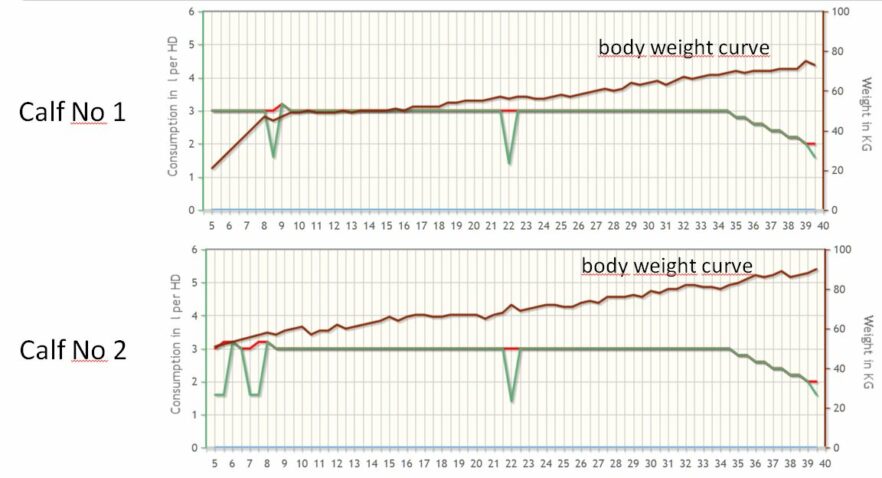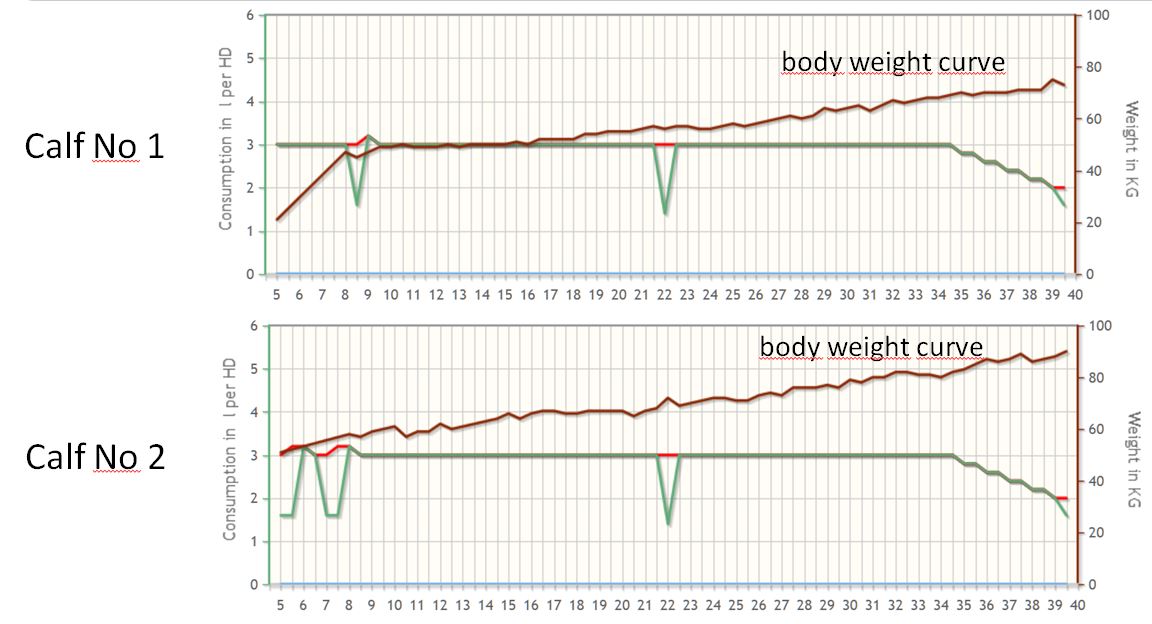“You can’t manage what you don’t measure!”
26. Februar 2021 — Weights, Calf management — #Body weight #Management #Animal weighing scales #Growth #WeightControl #Gains"You can’t manage what you don’t measure!"
This wise quote by management guru Peter Drucker applies to all areas of business and also to agriculture. Yet many decisions are still made on the basis of instinct.
This is true for calf rearing too: Many farmers accept and often strive to achieve the target of 800 – 1000 g weight gain per day. It is now well known that calves that grow faster through intensive rearing also give more milk later on. This effect is known as metabolic programming.
However, it is not possible to determine the exact growth of the calves without weighing them regularly. Less than 12 % of farms weigh their calves during the milk-diet phase. And only 9% of farms weigh calves at least twice[1]. This means that 91 % of farms do not determine the daily gains of their calves and thus have no information on their individual performance. How do these farms expect to make important decisions about feed strategies or animal selection?
This article will explain more about the different methods of weight recording and their benefits for successful calf rearing.
There are basically three ways of determining the weights of the calves:
- Measuring tapes
- Mechanical or electronic animal weigh scales
- Integrated scales in automatic calf feeders
[1] Own findings in international survey with 424 farms (2016)
Calf measuring tapes and barn charts
The simplest and cheapest way to record animal weights is using measuring tapes that measure the girth of the chest. You can easily read off the weight from a scale on the measuring tape and record it on stall cards. It should be borne in mind that the weight is, of course, only an estimate. However, the calculated weight gains are quite meaningful if the calves are measured regularly several times with the measuring tape.
It is important that measurements are taken several times during the drinking phase (at birth, and after 4, 8 and 12 weeks). It is only then that a complete picture of the calf's development emerges. The weights are then captured on stall cards and compared with the targets.
Mechanical or electronic animal weigh scales
Weight can be recorded more precisely using animal scales. Here, too, it is important to weigh the calves several times during rearing. As with the measuring tape, these values should also be recorded and compared on a stall card.
Newer electronic animal scales can be equipped with RFID antennas, record weight and then automatically store it for the corresponding calf. The data can often be exported to an Excel list and then processed further there.
It is much more convenient and meaningful when the data are automatically transferred to the management software. This makes the work of actually weighing much easier for employees. There are already systems on the market that allow additional information to be entered during weighing. When recording birth weight, information on the calving process, colostrum administration etc. can be entered directly at the terminal of the animal scales. This means that important information can be stored that can later be supplemented in the software with other information from calf feeders or MilkTaxis and consequently analysed in a holistic manner.
Integrated scales in automatic calf feeders
The most comprehensive weight information is obtained from animal scales that are integrated directly into the drinking station of calf feeders. The weight of the calves is recorded on each visit and extensive data are generated that provide information on the calves' development on a daily basis.
Since calves suffering from diarrhoea lose weight immediately, although they are actually still drinking quite well, they can be identified more quickly based on the alarm list by weight than on the list of milk consumption. Severe diarrhoea can often be avoided through early treatment, and the use of medication can be reduced.
The second important reason for equipping a feeder with scales is the possibility of weaning the calves from the milk depending on their individual weight development. This method weans calves that consume concentrate and roughage early from milk more quickly. This saves costs for milk replacer or whole milk and promotes the calves' further development into ruminants.
And in addition, the animal scales, when combined with management programs and analysis software, provide very detailed information on the calve sin the evaluation about how calves are likely to perform in the future. Various studies on the subject of "metabolic programming" show that calves with high feed intake and above-average growth also have a higher milk yield later in lactation. For example, Soberon et.al found that for 100 g of increased daily gain as a calf, 85-111 kg more milk was produced later in lactation. So if calves grow at 1000 g a day instead of 600 g, up to 450 kg more milk can be expected in the first lactation.
Thus, in addition to the genetic value of the calf, the information on animal weight provides another important piece of information when it comes to the question as to which heifers should stay on the farm and be reared and which animals should be sold. These additional selection parameters are becoming increasingly important, particularly in times when resource conservation and environmental regulations often call into question whether all animals should be reared.
It is also important to find out when the calves have grown. In the graph below, you can see the feeding and weight trajectories of two calves. Both calves were unremarkable with regard to their consumption and almost always consumed their full quantity. But it is clear that the first calf weighs just 75 kg at the end of the rearing, whilst the second calf ends the milk phase with a weight of approx. 90 kg. The first calf gained almost no weight in the period up to 20 days, whilst the second calf constantly grew at a rate of approx. 900 g / day.

The first 3 – 4 weeks in the life of a calf are decisive for the metabolic programming and the early udder development. Thus, the second calf should clearly be preferred over the first calf in the selection for the future dairy herd.
These points show that the quote from Peter Drucker is more topical than ever. It is rarely good to make management decisions based on human instinct. Choosing options based on little information is no better. In calf rearing, a lot of information must be gathered to set the right course on the farm. “Calves are the future of the farm!” says every second publication on the subject. Let us finally begin to act accordingly!

